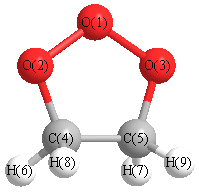Vibrational Frequencies calculated at CCSD=FULL/TZVP
| Mode Number |
Symmetry |
Frequency
(cm-1) |
Scaled Frequency
(cm-1) |
IR Intensities
(km mol-1) |
Raman Act
(Å4/u) |
Dep P |
Dep U |
|---|
| 1 |
A' |
3185 |
3018 |
27.87 |
|
|
|
| 2 |
A' |
3107 |
2944 |
45.22 |
|
|
|
| 3 |
A' |
1554 |
1473 |
0.23 |
|
|
|
| 4 |
A' |
1393 |
1320 |
0.35 |
|
|
|
| 5 |
A' |
1275 |
1208 |
1.41 |
|
|
|
| 6 |
A' |
1049 |
994 |
33.79 |
|
|
|
| 7 |
A' |
968 |
917 |
13.19 |
|
|
|
| 8 |
A' |
932 |
883 |
4.49 |
|
|
|
| 9 |
A' |
882 |
835 |
1.00 |
|
|
|
| 10 |
A' |
722 |
684 |
2.05 |
|
|
|
| 11 |
A' |
422 |
400 |
4.36 |
|
|
|
| 12 |
A" |
3168 |
3002 |
0.57 |
|
|
|
| 13 |
A" |
3097 |
2934 |
22.70 |
|
|
|
| 14 |
A" |
1536 |
1455 |
0.35 |
|
|
|
| 15 |
A" |
1385 |
1313 |
1.01 |
|
|
|
| 16 |
A" |
1243 |
1178 |
0.00 |
|
|
|
| 17 |
A" |
1188 |
1126 |
0.00 |
|
|
|
| 18 |
A" |
1061 |
1005 |
2.78 |
|
|
|
| 19 |
A" |
805 |
763 |
31.88 |
|
|
|
| 20 |
A" |
739 |
700 |
2.58 |
|
|
|
| 21 |
A" |
126 |
119 |
3.63 |
|
|
|
Unscaled Zero Point Vibrational Energy (zpe) 14918.1 cm
-1
Scaled (by 0.9475) Zero Point Vibrational Energy (zpe) 14134.9 cm
-1
See section
III.C.1 List or set vibrational scaling factors
to change the scale factors used here.
See section
III.C.2
Calculate a vibrational scaling factor for a given set of molecules
to determine the least squares best scaling factor.
